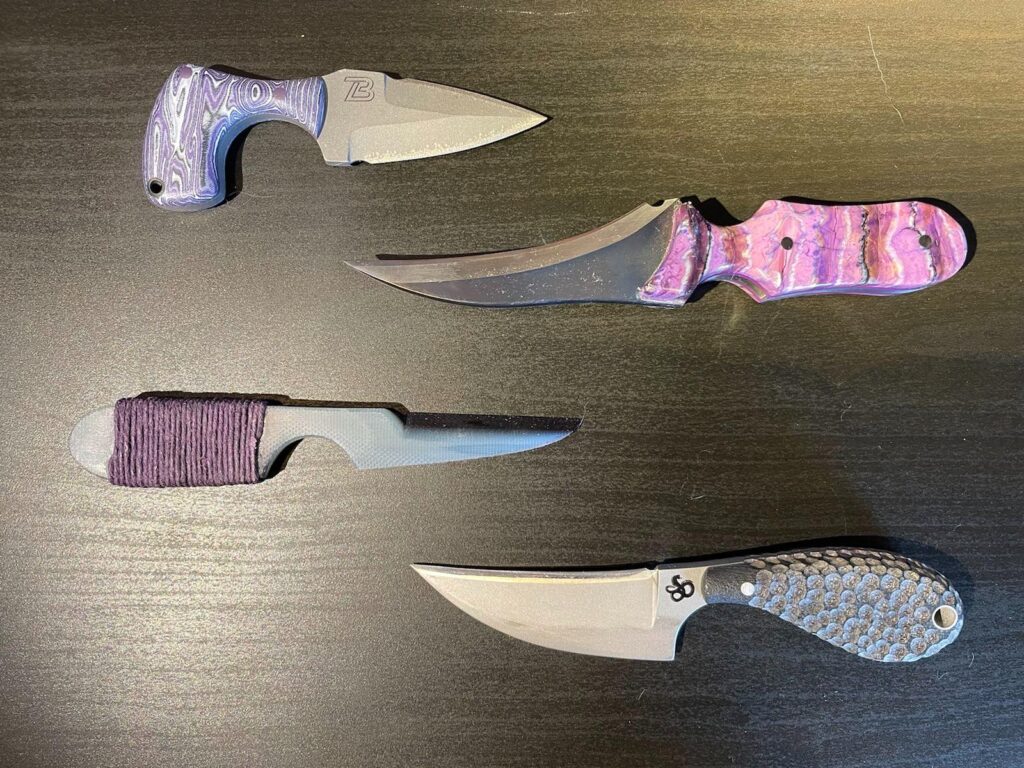
Knives are a popular suggestion for women’s self defense. They are often recommended because they’re relatively small and light, easy to carry, and apparently simple to use. A girl with a pocket knife doesn’t raise any eyebrows and it’s the rare woman who hasn’t felt safer at some point in her life because she had a knife in her purse or waistband. Because of that, I often get asked what suggestions I might have in the realm of bladed weapons. It’s a topic I’ve been avoiding for months at least, in fact, though, and here’s why:
They’re an incredibly complex answer to the problem of outfitting a woman to defend herself. While there are some specific and important upsides to carrying a blade, there are also some significant downsides. I want to start with the latter because until you can get past them, the rest is merely theoretical.
First, there’s the often-ignored fact that knives constitute lethal force. Even if you only mean to threaten an attacker by waving a knife, or you think that your little pen knife can’t do real harm, knives by definition can kill someone when you stab and cut someone with them. Like drawing a gun, holding a knife threatens death to the person you are facing. From a legal perspective, you can get in a whole lot of trouble using lethal force when you aren’t yourself reasonably threatened with death, rape, or other great bodily harm. It’s a nuanced topic but suffice it to say that you might not be able to bat your eyes and get away with having or using a legally inappropriate self defense tool. Perhaps more importantly, if you end up using that knife to defend yourself, you might kill somebody. No matter how much harm that person intended or did to you, you still might not be okay with that end. Whether you are or aren’t, you should figure it out before you commit yourself to a tool that can lead you there.
Then, too, is the fact that actually using a knife against another human being is a terrifyingly intimate form of violence. In order to stop someone by stabbing or cutting them, you will need to get up close and personal to make a lot of holes and let loose a lot of blood. Forget about how a dozen or more slashes or stab wounds might play to the news or a jury, you need to consider for yourself whether you can actually do that to someone. Even a strong sense of survival and willingness to fight for your life might not overcome the, frankly, squickiness of the feelings, sights, and sounds of using a knife in a desperate me-or-them struggle. You don’t want to find out you aren’t okay with that in that tiny moment after the first time you slide a blade into flesh and before the second time you must.
If, perhaps when, you can get over those mental hurdles, there are practical concerns as well. Unlike pepper spray, one can’t generally walk around with a knife ready to go in your hand. Instead, it’s the kind of tool that you normally have to grab as or after the attack begins. Accessing weapons inside of a fight can be an incredibly difficult problem to solve and requires some real skills to go with the determination to use anything you can to win your life. Without them, a knife shoved into a pocket or a purse, or even clipped to a waistband, might as well be as far away as the moon. It’s even harder if the choice is some sort of folding knife, which must also be opened – often requiring two hands in practice even if not in theory, and with a locking mechanism that might not be reliable against hard clothing barriers or bone. Either way, once you are able to deploy a knife, hanging on to it without dropping it or hurting yourself can be more challenging than it seems at first impression.
All that and blades are not very good at physiologically stopping determined attackers. Stab wounds and cuts are not always noticed or cared about, and they often don’t cause enough damage to make someone stop moving or living quickly enough to keep the defender safe from further injury from the bad guy. The idea of anatomical cuts that can disable a limb is attractive, but nearly impossible to effectively perform against someone who is actively moving around and who doesn’t want to be hurt. If relying on blood loss instead, it takes an awful long time for a human body to bleed out enough to stop functioning. Knives may be better than nothing, or better than some alternate choices, but that doesn’t necessarily make them a good choice for a particular person or in a particular setting.
Don’t get me wrong: I like the idea of knives for self defense and I carry them myself. The ones you see here are out of my personal collection. They may not be easy to get to in a fight, but they can be easier to get to than the alternative lethal force choice of a gun. They’re more comfortable to carry and simpler to conceal than, again, guns. Legality of possessing a knife intended for defensive use or that could be pressed into defensive use can be complicated, but often less difficult to navigate than other options. While expensive ones can certainly be had, knives that are well-suited for self defense can be had at reasonable prices that make using and losing them a surmountable cost for many people. Plus you can find ones that are pretty or cool-looking, whatever that means to you.
But they are neither a simple nor an easy solution that will automatically make you safer, and certainly not by simply having one with you. They can be difficult to deploy into a fight and to use in the midst of a fight. They require serious mental preparation and dedicated physical training. If you can work your way through those obstacles, then yes, a knife might be a good addition to your self defense repertoire. If not, then carrying one with you is only a talisman. A beautiful talisman, perhaps, but one that contributes to your safety only in the same way that a special piece of jewelry does.




